
Beer is a relatively small lunar impact crater located on the Mare Imbrium, to the east of the crater Timocharis. It was named after German astronomer Wilhelm W. Beer. Just to the northwest is the matching twin Feuillée.

Euclides is a small lunar impact crater located near the eastern edge of Oceanus Procellarum, about 30 kilometers to the west of the Montes Riphaeus mountains. The mare in the vicinity is devoid of significant craters, but to the west is an area of low rises. The crater is named after the Greek mathematician Euclid.

Boscovich is a lunar impact crater that has been almost completely eroded away by subsequent impacts. It is located west-northwest of the crater Julius Caesar, and south-southeast of the prominent Manilius. The crater floor has a low albedo, and the dark hue makes it relatively easy to recognize. The surface is crossed by the rille system designated Rimae Boscovich that extends for a diameter of 40 kilometres. The crater is named after Croatian physicist Roger Joseph Boscovich.

Artamonov is a lunar impact crater on the far side of the Moon. Its eroded outer rim does not have the circular shape of most lunar craters, but the overall shape of three or four merged craters. The largest is in the south, with smaller circular bulges to the north and east.

Fechner is a lunar impact crater that lies on the far side of the Moon's southern hemisphere, attached to the western rim of the large walled plain Planck. The eastern rim of Fechner intersects the Vallis Planck, a long, wide cleft in the surface that follows a course to the north-northwest. This valley intrudes into the southeastern rim of the crater, then continues northwards from the periphery of the northeast rim.

Becquerel is a lunar impact crater that lies in the northern hemisphere on the far side of the Moon. This is an ancient and heavily worn formation that is now little more than an irregular buri in the surface. The outer rim has been worn and reshaped until it forms a rugged, mountainous region around the flatter interior.
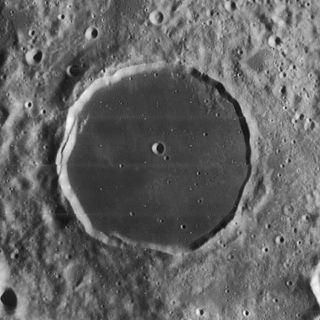
Crüger is a lunar impact crater that is located in the western part of the Moon, to the northeast of the much larger walled plain Darwin.

Leibnitz is a huge lunar impact crater that is located in the southern hemisphere on the far side of the Moon. This formation is the same size as Clavius on the near side. It is located to the east-southeast of Mare Ingenii, and is joined to the northeast rim of Von Kármán. Attached to the eastern rim of Leibnitz is Davisson, and intruding into the southeast rim is Finsen. Farther to the west is the large Oppenheimer.

Chauvenet is a lunar impact crater that is located to the northeast of the prominent crater Tsiolkovskiy on the far side of the Moon. Less than one crater diameter to the northwest of Chauvenet is the crater Ten Bruggencate.

Gibbs is a lunar impact crater that lies near the eastern limb of the Moon. It is situated less than a crater diameter to the northeast of the larger crater Hecataeus. The crater chain Catena Humboldt passes to the south of Gibbs, following a line to the northeast. Due to its proximity to the limb, this crater appears foreshortened when viewed from the Earth, and visibility is subject to libration.

Danjon is a lunar impact crater on the far side of the Moon. It lies less than a crater diameter to the east-southeast of the larger crater Langemak. To the east-northeast of Danjon is the crater Perepelkin, and due south lies the walled plain Fermi.

Das is a lunar impact crater on the far side of the Moon. It is located to the north-west of the walled plain Chebyshev. To the south-west of Das is the irregular crater Mariotte, and Von der Pahlen lies to the east-northeast. The crater was named after Indian astronomer Anil Kumar Das.

Denning is a lunar impact crater that is located on the far side of the Moon. It lies about midway between the craters Levi-Civita to the south and Marconi to the north-northeast. About two crater diameters to the southeast is the huge walled plain Gagarin.
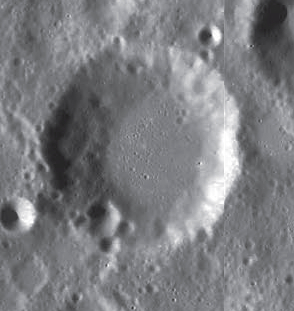
Dufay is a lunar impact crater that is located on the far side of the Moon. It lies about one crater diameter to the east of the large walled plain Mandel'shtam. To the northwest is the crater Papaleksi and to the east is Valier.
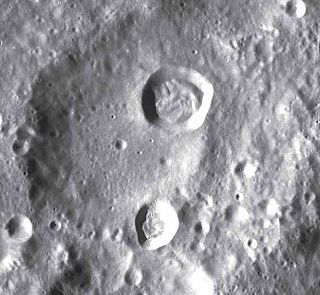
Ventris is a lunar impact crater on the far side of the Moon. It is located between the crater Schliemann just to the northwest and the large Keeler which lies slightly farther to the southeast. One crater diameter to the northeast is Vening Meinesz.

Vening Meinesz is a lunar impact crater on the far side of the Moon. The northern inner wall of this crater lies along the lunar equator. To the north of this formation is the larger crater Mandel'shtam, and slightly farther to the south is the larger Keeler. Dewar is located less than one crater diameter to the southeast of Vening Meinesz.

Maxwell is a crater on the far side of the Moon named after the physicist James C. Maxwell. It lies in the southwestern part of the larger crater Richardson. The southern part of Maxwell is overlain in turn by the partly flooded Lomonosov. Less than one crater diameter to the southwest is the larger Joliot.

Möbius is a lunar impact crater that is located on the Moon's far side, beyond the eastern limb and northeast of the Mare Marginis. It lies less than one crater diameter to the northwest of the larger, 90-km-diameter Hertz, and just to the southeast of Popov. To the north of Mobius is the crater chain designated Catena Dziewulski, which takes its name from the crater Dziewulski to the north-northwest.
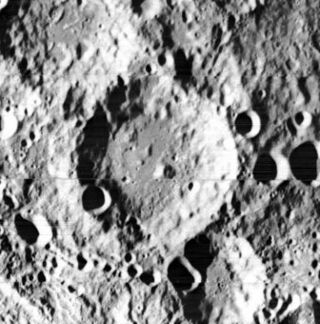
Stratton is a lunar impact crater on the Moon's far side. It is located to the north of the large craters Keeler and Heaviside, and less than one crater diameter to the south of Dewar.
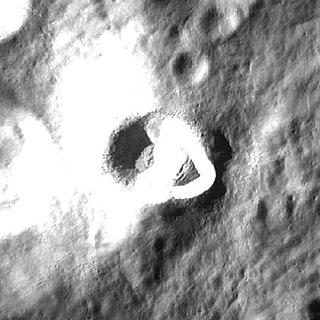
Ryder is a crater on the far side of the Moon. It is located in a patch of higher albedo surface material to the east of the larger Roche–Pauli crater pair. The name for this crater was officially approved at the IAU general assembly in 2006.























